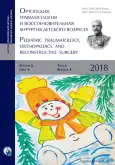X-ray evaluation of surgical treatment of the feet by using subtalar implants in patients with cerebral palsy
- Authors: Aleksandrov S.A.1, Syundyukov A.R.1, Yakovleva S.K.1
-
Affiliations:
- Federal Center of Traumatology, Orthopedics and Endoprosthesis Replacement
- Issue: Vol 6, No 4 (2018)
- Pages: 20-26
- Section: Original papers
- URL: https://bakhtiniada.ru/turner/article/view/6895
- DOI: https://doi.org/10.17816/PTORS6420-26
- ID: 6895
Cite item
Abstract
Introduction. Equino-plano-valgus deformity of the feet (EPvDS) in patients with cerebral palsy is one of the most common and functionally significant pathologies of the lower extremities, which leads to changes in the shape of the feet, decreased support, and disturbance of gait biomechanics. An important task is to determine the effective methods of treating this pathology (and their combinations) to correct or reduce the severity of these disorders. The evaluation of the radiological changes occurring with the foot is also important.
Aim. The paper assesses the changes in the main X-ray significant indicators of the foot by using rammed implants in the treatment of mobile EPvDS in children with cerebral palsy.
Materials of the study. The assesses of radiological results of treatment of 64 patients from 6 to 17 years with mobile EPvDS and cerebral palsy have been analyzed using subtalar implants.
The results of study showed that 94% of cases showed good and satisfactory indicators, whereas 6% of patients showed unsatisfactory results.
Conclusion. High efficiency was shown by using subtalar implants combined with tenodesis and transposition of the anterior tibial muscle tendon in the treatment of mobile EPvDS in children with cerebral palsy of early and middle childhood.
Full Text
##article.viewOnOriginalSite##About the authors
Sergey A. Aleksandrov
Federal Center of Traumatology, Orthopedics and Endoprosthesis Replacement
Author for correspondence.
Email: saleksandrov@orthoscheb.com
MD, Orthopedic Trauma Physician
Russian Federation, 33, F.Gladkova street, Cheboksary, Chuvash Republic, 428020Ayrat R. Syundyukov
Federal Center of Traumatology, Orthopedics and Endoprosthesis Replacement
Email: asiundiukov@orthoscheb.com
MD, PhD, head of children’s traumatological and orthopedic
Russian Federation, 33, F.Gladkova street, Cheboksary, Chuvash Republic, 428020Svetlana K. Yakovleva
Federal Center of Traumatology, Orthopedics and Endoprosthesis Replacement
Email: syakovleva@orthoscheb.com
MD, Pediatrician
Russian Federation, 33, F.Gladkova street, Cheboksary, Chuvash Republic, 428020References
- Долгих В.В., Власенко А.В., Ледяева Н.П., и др. Опыт применения высоких технологий в реабилитации детей со спастическими формами детского церебрального паралича // Вестник Росздравнадзора. – 2014. – № 3. – С. 24–27. [Dolgikh VV, Vlasenko AV, Ledyaeva NP, et al. Opyt primeneniya vysokikh tekhnologiy v reabilitatsii detey so spasticheskimi formami detskogo tserebral’nogo paralicha. Vestnik roszdravnadzora. 2014;(3):24-27. (In Russ.)]
- Куренков А.Л., Клочкова О.А., Бурсагова Б.И., и др. Применение препарата ботулинистического токсина типа А (Ботокс) в лечении детского церебрального паралича // Нервно-мышечные болезни. – 2014. – № 3. – С. 28–41. [Kurenkov AL, Klochkova OA, Bursagova BI, et al. Use of botulinum toxin type A (Botox) in the treatment of infantile cerebral palsy. Neuromuscular diseases. 2014;(3):28-41. (In Russ.)]
- Союз педиатров России. Федеральные клинические рекомендации по оказанию медицинской помощи детям с детским церебральным параличом. – М., 2013. [Soyuz pediatrov Rossii. Federal’nye klinicheskie rekomendatsii po okazaniyu meditsinskoy pomoshchi detyam s detskim tserebral’nym paralichom. Moscow; 2013. (In Russ.)]
- Бадалян Л.О. Детская неврология. – М., 1984. [Badalyan LO. Detskaya nevrologiya. Moscow; 1984. (In Russ.)
- Умнов Д.В. Способы оперативной коррекции мобильной эквино-плано-вальгусной деформации стоп у детей с детским церебральным параличом (обзор литературы) // Травматология и ортопедия России. – 2009. – №3. – С. 93–100. [Umnov DV. The methods of the surgical correction of the mobile equino-plano-valgus deformation feet in the children with cerebral palsy: the crux of the matter according to the literature data. Travmatologiia i ortopediia Rossii. 2009;(3):93-100. (In Russ.)]
- Bennet GC, Rang M, Jones D. Varus and valgus deformities of the foot in cerebral palsy. Dev Med Child Neurol. 1982;24(4):499-503. doi: 10.1111/j.1469-8749.1982.tb13656.x.
- O’Connell PA, D’Souza L, Dudeney S, Stephens M. Foot deformities in children with cerebral palsy. J Pediatr Orthop. 1998;18(6):743-747.
- Yoo WJ, Chung CY, Choi IH, et al. Calcaneal lengthening for the planovalgus foot deformity in children with cerebral palsy. J Pediatr Orthop. 2005;25(6):781-785. doi: 10.1097/01.bpo.0000184650.26852.37.
- Bourelle S, Cottalorda J, Gautheron V, Chavrier Y. Extra-articular subtalar arthrodesis. A long-term follow-up in patients with cerebral palsy. J Bone Joint Surg Br. 2004;86(5):737-742. doi: 10.1302/0301-620X.86B5. 14170.
- Evans D. Calcaneo-valgus deformity. J Bone Joint Surg Br. 1975;57(3):270-278. doi: 10.1302/0301-620X. 57B3.270.
- Kwak YH, Park KB, Park HW, Kim HW. Use of allograft in skeletally immature patients for calcaneal neck lengthening osteotomy. Yonsei Med J. 2008;49(1):79-83. doi: 10.3349/ymj.2008.49.1.79.
- Mosca VS. Calcaneal lengthening for valgus deformity of the hindfoot. Results in children who had severe, symptomatic flatfoot and skewfoot. J Bone Joint Surg Am. 1995;77(4):500-512.
- Zorer G, Bagatur AE, Dogan A, Unlu T. Dennyson-Fulford subtalar extra-articular arthrodesis in the treatment of paralytic pes planovalgus and its value in the alignment of the foot. Acta Orthop Traumatol Turc. 2003;37(2):162-169.
- Vedantam R, Capelli AM, Schoenecker PL. Subtalar arthroereisis for the correction of planovalgus foot in children with neuromuscular disorders. J Pediatr Orthop. 1998;18(3):294-298.
Supplementary files











